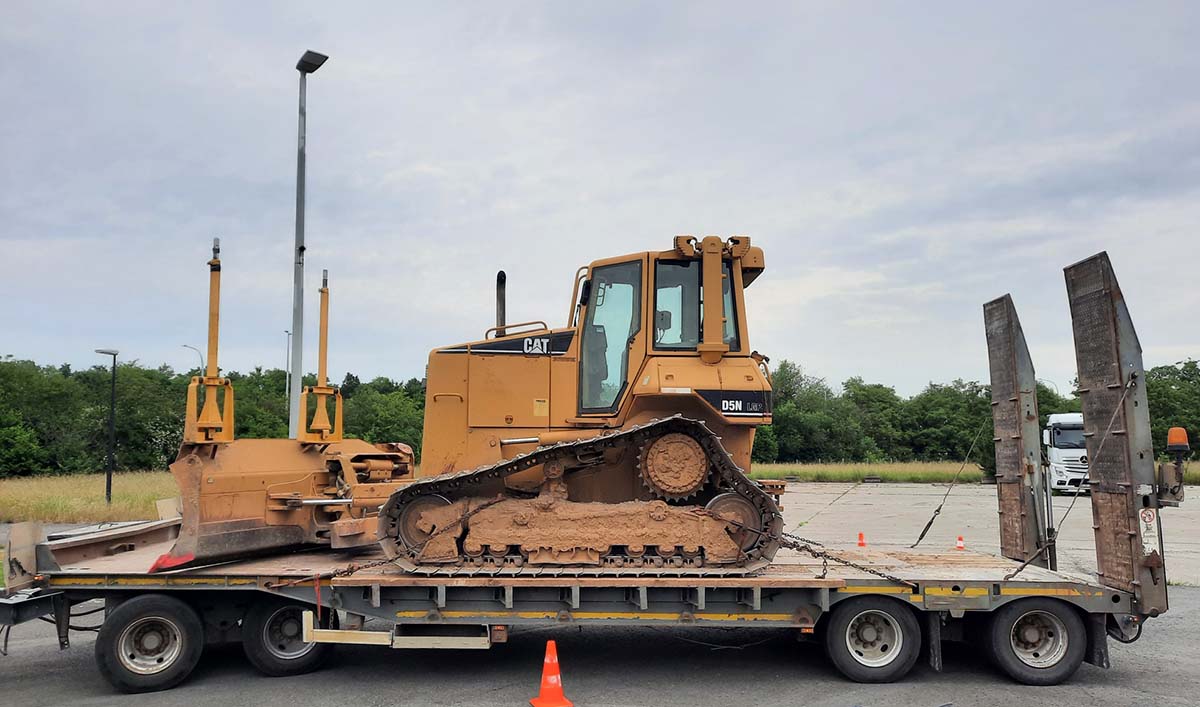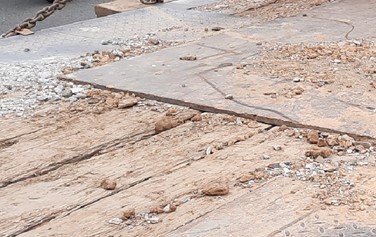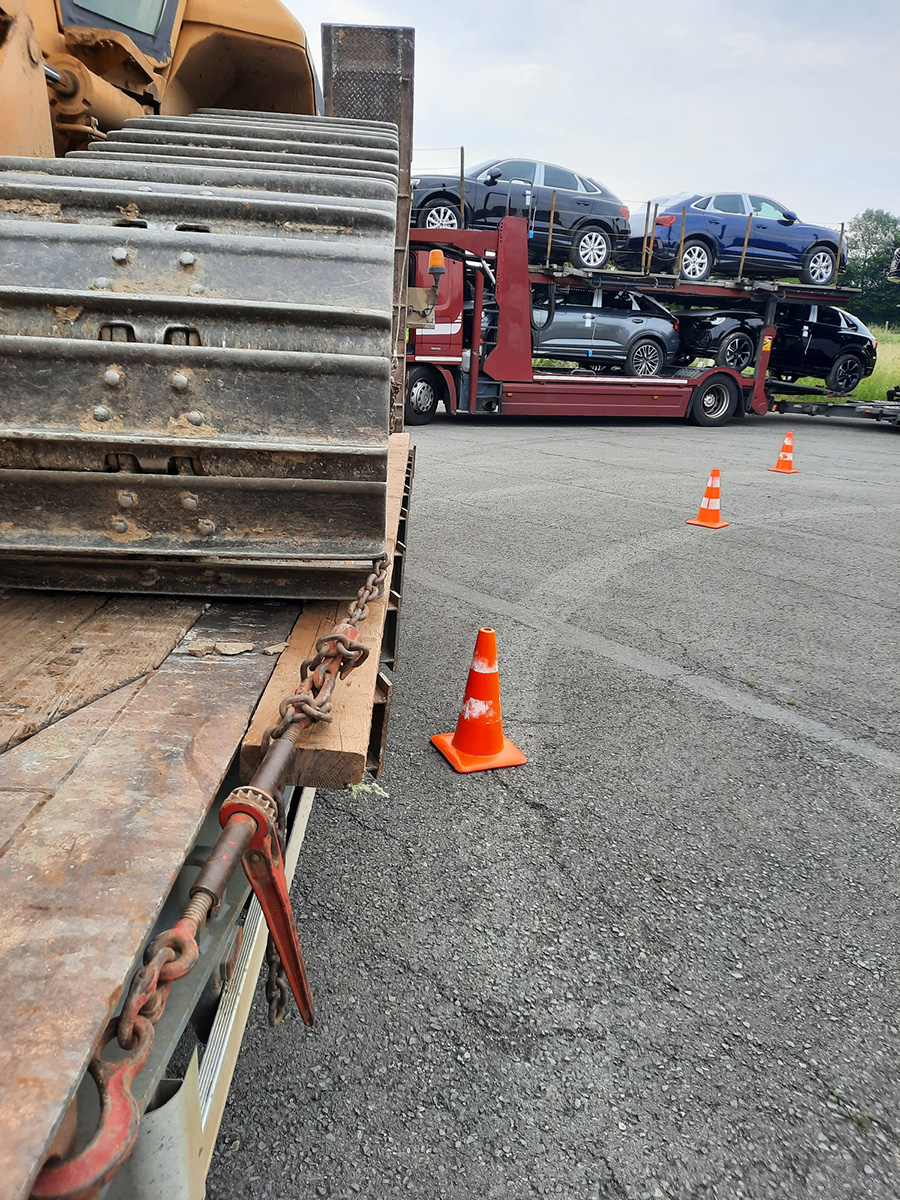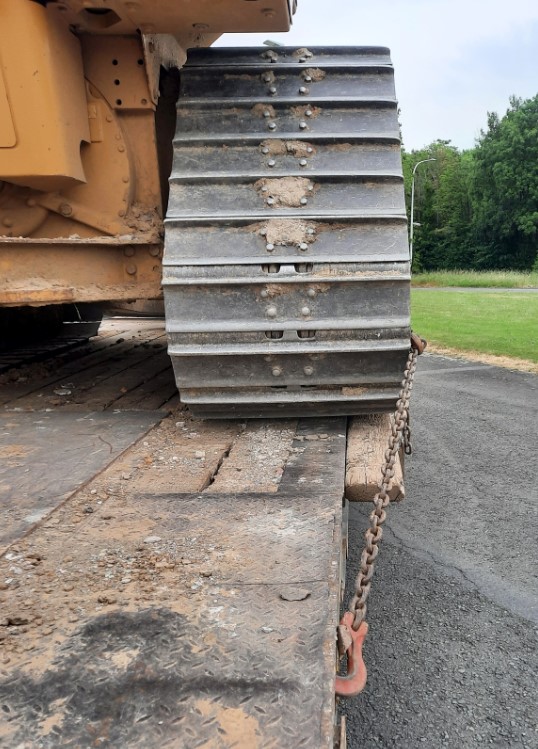| Photo of the month – March 2024 |
[German version] |
Can bulldozers slip?
Or are they just too heavy to move?

Figure 1 [Raymond Lausberg]
According to the Internet, this bulldozer weighs in at between 17.5 and 19.2 tonnes. For the purposes of today’s article, we will use the value of 19.2 tonnes. It is therefore necessary to secure 15,360 daN in the direction of travel and 9,600 daN laterally.
The first question that any keen load securing specialist would ask here is “what is the friction on this trailer”?

Figure 2 [Raymond Lausberg]
Figure 2 fails to provide us with much by way of an answer. We hope we may be forgiven for saying that this loading surface is an absolute tip It is filthy and covered with stones, gravel, sand, earth and even clay. It not only shows evidence of considerable wear and tear but is also in need of some repair work, and indeed some has also been carried out in certain places. We are not sure whether we would find all the material (stones, gravel and earth) still on the loading surface at the end of the journey or whether a few of the stones might have flown off to damage the windshields of other road users.
However, that is merely a side effect. Let us return to the question of friction. One thing that we are sure of is that the friction on this loading surface is very difficult to ascertain. Clean chains on the frayed wood would undoubtedly have a good μ = 0.3 of friction. However, the loading surface also appears to consist of other materials such as textured, coated board (at least, that is what it looks like), steel beams and durbar sheets. All of this assorted with a goodly portion of gravel, sand, clay and stones. Making this trailer a scene of rubble and debris. A broom could have worked wonders! But what shall we do about the friction?
A core aspect of load securing is safety and so, to be on the safe side and because (even) we do not know exactly what friction is at work here, we will assume a value of μ = 0.1. Our approach might seem excessive but it is more than justified. In any case, vehicles like these always need robust load securing measures – in this case, chains. These can then be laid out in a way that caters for all needs. That means that the chains and the load securing points at the trailer and the load are dimensioned in such a way that they can be used to secure the entire load.

Figure 3 [Raymond Lausberg]
The attached chains have practically no lateral component, which has a value in the low single figures. This means that the entire lashing capacity (LC) is acting in the direction of travel. From this, we also have to deduct a small vertical component. We can determine the value of this easily using our cookbook.
To make a rough calculation, we will assume 100% effectiveness in the direction of travel. Unfortunately, we have to estimate the LC of the chains because we do not have the associated specifications. We will assume an LC of 5,000 daN. For the purposes of our rough calculation, that means a securing force of 10,000 daN in the direction of travel. However, given a weight of 19.2 tonnes and a coefficient of friction of 0.1, we would actually have needed 13,440 daN. This is yet another illustration of the outstanding effect of friction. If we had been able to assume a value of μ = 0.3 for the friction then we would “only” have needed to find another 9,600 daN in the direction of travel and the securing force would have just been enough in this direction.
How can we overcome this shortfall? First of all, the load securing points on the vehicle must be suitable for securing the load. In Figure 4, we can see that the tip of the hook is taking the strain, meaning that this load securing point is not designed for this type of hook. If all the different elements were compatible then two chains with an LC of 10,000 daN each would be optimal. If the loading surface were clean then these chains would also be able to take care of the load securing to the side. Here again, our cookbook helps us position the load securing points in such a way that the longitudinal and lateral components are distributed correctly.
Load-securing to the rear:
Here we need 19,200 daN weight force x 0.4 = 7,680 da. This is easily provided by the two chains and so the load securing here is fine.
Load securing to the sides:
Figure 4 shows that the chains have only a very small lateral component, meaning that there is almost no load securing to the side. Given the coefficient of friction of μ = 0.1 used in our calculations, we need to apply 7,680 daN at the side. Since the chains employed here are probably too weak, it is necessary to use four more pieces of load securing equipment transversely to the direction of travel.

Figure 4 [Raymond Lausberg]
When we witness such disregard for road safety and other road users, we have to ask what it is that makes drivers act in this way. Is it economic pressure? Even though it may be difficult to clean a bulldozer at the building site, one look at the loading surface and the attached chains from the side is enough to know perfectly well that you would not want these deposits to come loose and land on your windshield when approaching this trailer on the opposite side of the road or overtaking it on the motorway. The driver’s boss wouldn’t like it either.
Your load securing columnists wish you a clean loading surface and a clean load at all times.
Back to beginning
